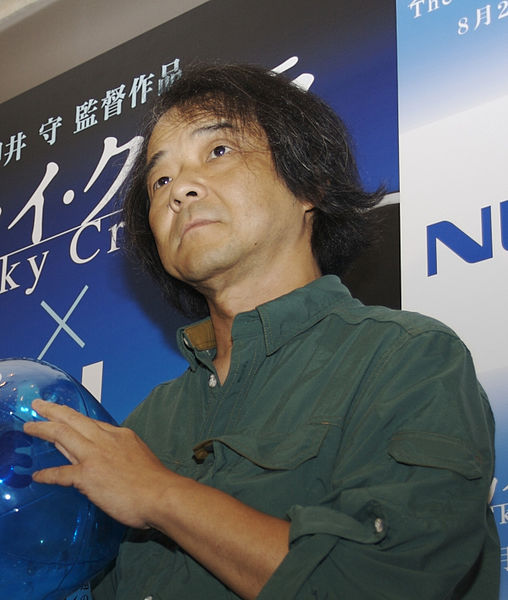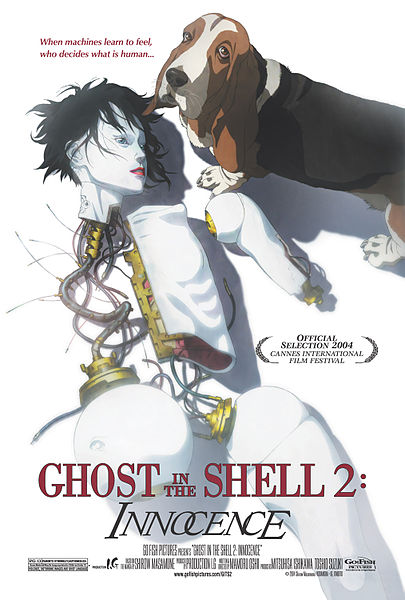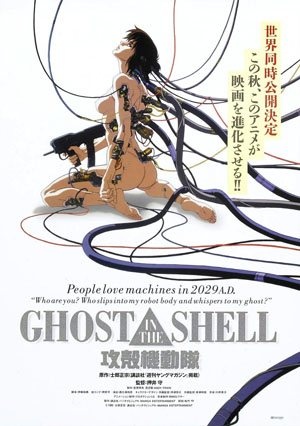<Back to Index>
- Film Director, Screenwriter and Manga Artist Mamoru Oshii, 1951
PAGE SPONSOR



Mamoru Oshii (押井 守 Oshii Mamoru; born August 8, 1951 in Tokyo) is a Japanese filmmaker, television director, and writer. Famous for his philosophy oriented storytelling, Oshii has directed a number of popular anime, including Urusei Yatsura 2: Beautiful Dreamer, Ghost in the Shell, and Patlabor 2: The Movie. He also holds the distinction of having created the first ever OVA, Dallos. For his work, Oshii has received and been nominated for numerous awards, including the Palme d'Or and Golden Lion. He has also attracted praise from international directors such as James Cameron and the The Wachowskis.
Oshii lived in Atami,
Shizuoka Prefecture, Japan with his dog – a mutt named Daniel.
As a student, Mamoru Oshii was fascinated by the film La jetée by Chris Marker. He also repeatedly watched European cinema, such as films by Federico Fellini, Ingmar Bergman, Michelangelo Antonioni and Jean - Pierre Melville. These filmmakers, together with Jean - Luc Godard, Andrei Tarkovsky and Jerzy Kawalerowicz, would later serve as influences for Oshii's own cinematic career.
In 1976, he graduated from Tokyo Gakugei University. The following year, he entered Tatsunoko Productions and worked on his first anime as a storyboard artist on Ippatsu Kanta-kun. During this period at Tatsunoko, Oshii worked on many anime as a storyboard artist, most of which were part of the Time Bokan television series. In 1980, he moved to Studio Pierrot under the supervision of his mentor, Hisayuki Toriumi.
Mamoru Oshii's work as director and storyboard artist of the animated Urusei Yatsura TV series brought him into the spotlight. Following its success, he directed two Urusei Yatsura films: Urusei Yatsura: Only You (1983) and Urusei Yatsura 2: Beautiful Dreamer (1984). While the first film, though an original story, continued much in the spirit of the series, Beautiful Dreamer (which was also written by Oshii with no consultation from Takahashi) was a significant departure and an early example of his now contemporary style.
In
the midst of his work with Studio Pierrot, Oshii took on
independent work and directed the first OVA, Dallos, in 1983.
In 1984, Oshii left Studio Pierrot. Moving to Studio Deen,
he wrote and directed Angel's Egg (1985), a
surreal film rich with Biblical symbolism, featuring the
character designs of Yoshitaka Amano. The producer of the
film, Toshio Suzuki, later founded the renowned Studio
Ghibli with Hayao Miyazaki and Isao Takahata. Following
the release of the film, Miyazaki and Takahata began
collaborating with Mamoru Oshii on his next film, Anchor.
The film was canceled early in the initial planning stages
when the trio had artistic disagreements.
Despite their differences, Toshio Suzuki and Studio Ghibli
would later help Oshii with his production of Ghost in
the Shell 2: Innocence (2004). To this day, Oshii
maintains skeptical, but respectful, views of each of
Takahata and Miyazaki's films. Though he has been critical
of Miyazaki's attitude towards his workers, he also claims
that he would feel "strangely empty" and "it would be
boring" if both Miyazaki and Takahata stopped making
films.
In the late 1980s, Oshii was solicited by his friend Kazunori Itō to join Headgear as a director. The group was composed of Kazunori Itō (screenwriter), Masami Yuki (manga artist), Yutaka Izubuchi (mechanical designer), Akemi Takada (character designer) and Mamoru Oshii (director). Together they were responsible for the Patlabor TV series, OVA, and films. Released in the midst of Japan's economic crisis, the Patlabor series and films projected a dynamic near future world in which grave social crisis and ecological challenges were overcome by technological ingenuity, and were a big success in the mecha genre.
Between production of the Patlabor movies/series, Oshii
delved into live action for the first time, releasing his
first non-animated film, The Red Spectacles
(1987). This led to another live action work titled Stray Dog: Kerberos Panzer Cops
(1991); both films are part of Oshii's ongoing Kerberos
saga. Following Stray Dog Oshii made yet
another live action film, Talking Head (1992),
which is a surreal look at his view on film.
In 1995, Mamoru Oshii released his landmark animated cyberpunk film, Ghost in the Shell, in Japan, the United States, and Europe. It hit the top of the US Billboard video charts in 1996, the first anime video ever to do so. Concerning a female cyborg desperate to find the meaning of her existence, the film was a critical success and is widely regarded to be a masterpiece and anime classic.
After a 5-year hiatus from directing to work on other projects, Oshii returned to live action with the Japanese - Polish feature Avalon (2001), which was selected for an out of competition screening at the Cannes Film Festival. His next animated feature film was the long-awaited sequel to Ghost in the Shell, titled Ghost in the Shell 2: Innocence. Four years in the making, the film focuses on Batou as he investigates a series of gruesome murders, while trying to reconcile with his deteriorating humanity. Though it received mixed reviews, Innocence was selected to compete at the 2004 Cannes Film Festival for the coveted Palme d'Or prize, making it the first (and thus far, only) anime to be so honored.
Oshii was approached to be one of the directors of The Animatrix, but he was unable to participate because of his work in Innocence. Following Innocence, Oshii also contemplated directing a segment for the anthology film Paris, je t'aime, but ultimately declined the offer. Meanwhile, in 2005, there were talks of a Kenta Fukasaku and Oshii collaboration. It was announced that Oshii would write the script for a film titled Elle is Burning, as well as provide CGI consultation, while Fukasaku would direct. Although Oshii completed the script, the film was inevitably shelved because, among other problems, the large budget it would require.
His next film, The Sky Crawlers (2008), competed
for the Golden Lion in the Venice Film Festival. In the
film, Oshii posits an alternate history in which war has
been privatized; children are manufactured and sent to
aerial battles which are exploited for commercial
entertainment. Subsequent to The Sky Crawlers,
Oshii wrote the screenplay to the Production I.G film Musashi:
The Dream of the Last Samurai, which has been
described as possibly the first ever anime documentary.
In 2009, he wrote and directed the live action feature Assault
Girls and served as creative director for the
Production I.G-produced segment of the animated short film
anthology Halo Legends. Later, Oshii announced his
next film will be an adaptation of Mitsuteru Yokoyama's Tetsujin-28 manga. The
Tetsujin-28 project turned out to be a live action film
called '28 1/2'.
Oshii has stated his approach to directing is in direct contrast to what he perceives to be the Hollywood formula, i.e. he regards the visuals as the most important aspect, followed by the story and the characters come last. He also notes that his main motivation in making films is to "create worlds different from our own."
Mamoru Oshii's films typically open with an action sequence. Thereafter, the film usually follows a much slower rhythm punctuated by several sequences of fast action. Oshii also frequently inserts a montage sequence in each of his movies, typically two minutes long, muted of dialogue and set against the backdrop of Kenji Kawai's music. Recurrent imagery include reflections/mirrors, flocks of birds, and basset hounds similar to his own. The basset hound was seen most prominently in Ghost in the Shell 2: Innocence, and was a major plot point in his live action film, Avalon. The Mauser C96 also appears periodically in his films.
Oshii is especially noted for how he significantly strays from the source material his films are based on, notably in his adaptations of Urusei Yatsura, Patlabor and Ghost in the Shell. In their original manga versions, these three titles exhibited a mood that was more along the lines of frantic slapstick comedy (Urusei Yatsura) or convivial dramedy (Patlabor, Ghost in the Shell). Oshii, in adapting the works created a slower, more dark atmosphere especially noticeable in Urusei Yatsura 2: Beautiful Dreamer and Patlabor 2: The Movie. For the Ghost in the Shell movie, Oshii elected to leave out the humor and character banter of Masamune Shirow's original manga.
"Oshii's work... steers clear of such stereotypes in both image and sexual orientation," wrote Andrez Bergen in an article on Oshii that appeared in Japan's Daily Yomiuri newspaper in 2004. "His movies are dark, thought provoking, minimalist diatribes with an underlying complexity; at the same time he pushes the perimeters of technology when it comes to the medium itself. Character design plays equitable importance."
Oshii also wrote and directed several animated movies and
live-action films based on his personal world view,
influenced by the anti - AMPO student movements of the
1960s and 1970s in which he participated.
The anti - AMPO student movements were protests during
1960s Japan against the Treaty of Mutual Cooperation and
Security between the United States and Japan. The first
film to touch on this political background was the live action film The Red
Spectacles. This film, set in the same world as the
Oshii scripted film Jin-Roh: The Wolf Brigade
(1999), is about a former member of the special unit of
the Tokyo Metropolitan Police Force dealing with a fascist
government.
The Wachowskis are known to have been impressed with Ghost in the Shell and went as far as to screen it to producer Joel Silver to show him what kind of film they wanted to make for The Matrix. Indeed, various scenes from Ghost in the Shell have been seemingly lifted and transposed in The Matrix. Ghost in the Shell was also the chief inspiration for the video game Oni.
Kenji Kamiyama, the director of the Ghost in the Shell: Stand Alone Complex television series, considers Oshii his mentor, and states that he tried to copy Oshii's entire style when creating the Stand Alone Complex series, believing that audiences would be tricked into thinking Oshii had directed the series.
Many have also noted the similarities in the Helghast design from the Killzone series of video games to the Kerberos Panzer Protect Gear, first seen in the 1987 film The Red Spectacles. Asked of these observations, Guerilla Games, video game developer for the Killzone series, did not address the similarities. The developers contend the Helghast design was inspired by the gas masks of WWI, though this does not account for the similarity in the glowing red/orange eyes between the two designs.
James Cameron is another filmmaker who has voiced his admiration for Oshii, stating at one point that Avalon was "the most artistic, beautiful and stylish sci-fi film." He also praised Ghost in the Shell, stating it was "the first truly adult animation film to reach a level of literary and visual excellence."
Oshii also had a get-together with Duncan Jones.
Mamoru Oshii has worked extensively with Production I.G. Every animated film he has made since Patlabor: The Movie (1989) has been produced under the studio. He also worked closely with screenwriter Kazunori Itō; they made five films together, beginning with The Red Spectacles and ending with Avalon. His closest colleague, however, is music composer Kenji Kawai. Kawai has composed most of the music in Oshii's work, including ten of his feature films. According to Oshii, "Kenji Kawai's music is responsible for 50 percent of [his] films' successes" and he "can't do anything without [Kenji Kawai]."
The Kerberos saga is Mamoru Oshii's lifework, created in 1986. A military science fiction franchise and alternate history universe, it spans all media and has lasted for more than 20 years since his January 1987 radio drama While Waiting For The Red Spectacles. In 1987, Oshii released The Red Spectacles, his first live action feature and the first Kerberos saga film. The manga adaptation, Kerberos Panzer Cop, written by Mamoru Oshii and illustrated by Kamui Fujiwara, was serialized in 1988 until 1990.
Acts 1~4 of Kerberos Panzer Cop was compiled in 1990 as a single volume. In 1991, the live action film adaptation of the tankōbon was released as StrayDog Kerberos Panzer Cops. In 1999, the Oshii scripted Jin-Roh: The Wolf Brigade, the anime feature film adaptation of the manga's first volume, was directed by Oshii's collaborator Hiroyuki Okiura, and was released in International Film Festivals starting in France.
In 2000, the second part of the manga (Acts 5~8) was serialized, then published and compiled as a second volume. After the manga's completion and publishing as volumes 1 and 2, Jin-Roh: The Wolf Brigade was finally released in Japan during the same year. In 2003, Kerberos Panzer Cop's sequel, Kerberos Saga Rainy Dogs was serialized, then compiled as a single volume in 2005. In 2006 Kerberos Panzer Jäger was broadcast in Japan as a 20 year celebration of the saga. The same year, Oshii revealed his plan to release an anime/3DCG adaptation film of the drama in 2009, the Kerberos Panzer Blitzkrieg project. In late 2006, Oshii launched a Kerberos saga crossover manga series titled Kerberos & Tachiguishi.
In addition to his directing work, Oshii is a prolific
screenwriter and author of manga and novels. As well as
writing the Kerberos series of manga, Oshii wrote the
script for the manga Seraphim 266,613,336 Wings
illustrated by Satoshi Kon. He also wrote the
screenplay of Jin-Roh: The Wolf Brigade and is
credited as a co-planner for Blood: The Last Vampire
(2000)
and Blood+.
Oshii is also credited as providing "story concept" for Ghost
in the Shell: S.A.C. 2nd GIG, though he asserts he
was tasked to supervise and provide the plots for all 26
episodes of the series. In 2005 Oshii served as supervisor
for the Mobile Police Patlabor Comes Back: MiniPato
video game. In 2008, he again served as special consultant
for the development of a video game, The Sky Crawlers:
Innocent Aces.